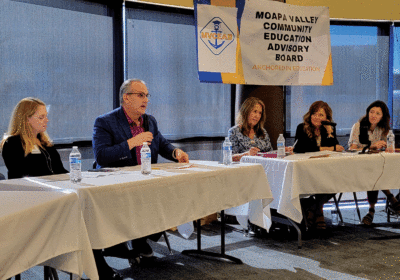By VERNON ROBISON
The Progress

Clark County School District (CCSD) Superintendent Jesus Jara pledged last week to work together more closely with education advocates in both Moapa Valley and Virgin Valley to address a series of unresolved issues in area schools. This took place at a meeting of the Moapa Valley Community Education Advisory Board (MVCEAB) on Friday, Nov. 17 held at Moapa Valley High School.
Jara himself had requested the meeting back in June when the MVHS School Organizational Team (SOT) had raised a number of issues surrounding the loss of the 8-period block schedule at the school.
Also in attendance at the meeting were members of the Virgin Valley Community Education Advisory Board (VVCEAB) representing students and parents at Virgin Valley High School which had suffered a similar loss this year.
“I believe that when we get smart people into the room to discuss problems, that we can always find a solution,” Jara said at Friday’s meeting. “We can get together and find a solution on behalf of the students because that is the common thread between all of us here; it’s the kids.”
Jara listened carefully to a presentation from various members of the MVHS SOT detailing a series of three interconnected issues that were at the heart of their concerns.
MVHS block schedule
The first of these was the loss of the eight period block schedule. SOT members Kenna Dalley and Bryan Linford, both teachers of elective offerings at MVHS, talked about how the block schedule had allowed students a broader range of course offerings than could be received through the more conventional 6-period schedule.
This school year, both MVHS and VVHS had to drop the block schedule because of questions from CCSD on whether it was in full compliance with state regulations.
“When these questions came up last year, the state came in and did an attendance audit of our school,” said Higgins. “We were pleased to say that we passed it with flying colors. The state found that we were in full compliance with (state regulation) as well as CCSD regulation and that (we) met the number of (instructional) minutes per day required by Nevada Revised Statute.”
Despite this, CCSD stood on the opinion that the school was out of compliance which forced school administrators to reduce course offerings into a six period day, Higgins said.
As a result the school had to reduce its already limited Career Technical Education (CTE) course offerings, Higgins said. Every elective and CTE teacher has lost one full section in the change, she said.
“The six period schedule makes it difficult for our students to fulfill the CTE course credits needed for graduation,” Linford added. “As a result, fewer students are on track with their CTE credits and thus, fewer are on track for graduation.”
Linford said that part of the problem of these lost opportunities stemmed from the small size of the rural school. “High schools in Vegas have the capacity to offer choices because they have larger faculty and staff,” he said. “A small rural school like MVHS, has a limited staff and most teachers are teaching multiple subjects. That means that our class schedule becomes very tight.”
Small school allocation
This led to the second issue presented by the SOT which was that of adequately funding a small school. SOT member Mandie Matheson explained that the CCSD has long had a funding formula to prop up opportunities in its smallest schools. This gives those schools funding for extra teachers based on the population of the school.
Matheson said that the CCSD chart for small school funding was created more than two decades ago and was no longer relevant. “Mathematically it makes zero sense in today’s environment,” she said.
In the case of MVHS, the school had received four extra teacher positions over the past two school years while the student population stayed between the range of 444-591. But this year, the student population reached 592 and entered a new threshold. Consequently, one teacher position was lost; a $105,000 cut to the school’s budget.
“But we are still a small school with limited resources,” Matheson said.
SOT member Terry Holzer proposed some possible solutions to this problem. The first was to increase the population ranges in the formula by 25 students. The second proposal was to create a sliding scale so that the increase of one student doesn’t result in such a sudden catastrophic loss to the school.
“If we fall on the edge, we propose that maybe we lose a percentage of a teacher as compared to a full teacher position,” Holzer said.
Hold harmless clause
The third topic, presented by SOT member Mark Cottle, regarded a “hold harmless” requirement in a 2015 state law which set about to reorganize CCSD. This clause insisted that rural school budgets should be held harmless by remaining substantially the same as their 2016/17 budget, the year that the law was passed.
Cottle explained that the position of CCSD was that in 2016-17 year, the MVHS budget was operating at 123 percent of urban schools. So that percentage was simply frozen to meet the “hold harmless” clause.
But this approach didn’t really hold the school harmless, Cottle said. Instead it was used against the school in the current year, he said.
“MVHS received $282,000 to pay the three additional teachers as according to the CCSD Small School funding formula,” Cottle said. “Then CCSD took $282,000 away because they said we had too much money to operate the school under the hold harmless clause.”
Cottle said that the real intent of “hold harmless” was that the school should retain the same number of teachers and support staff as compared to 2016-17, proportionate to the school’s student population. Thus, with the population increasing by more than 100 students since that year, the school should have added more than four teachers. Instead only 2 teachers have been added, Cottle said.
“In our opinion as a SOT, the school is not being funded in the same way now as it was in the 2016-17 school year,” Cottle said. “We feel that CCSD has not followed the hold harmless formula as it was intended.”
Cottle concluded by pointed out that, if the six day schedule is continued into next school year, the school would lose four electives and CTE teachers. These would have to be replaced by core academic teachers to address increases in class sizes.
“So I would ask you, Superintendent Jara, what programs or classes would you like us to eliminate?” Cottle asked. “Do we drop Robotics, Theatre, Art, Music? Or do we lose AP and honors classes? Just remember, in a small school, if we lose a teacher, we lose an entire program.”
Seeking clarification
After the presentation, Jara spoke briefly to address some of the concerns.
On the subject of the block schedule, Jara said that there was still some ambiguity between the state regulation and the state law on the matter. He said that he had contacted the State Department of Education and asked for clarification on the matter but had never received it.
“My solution is that we, as a collective team, work together to send the State Superintendent a letter to request clarity on this,” Jara said.
Jara acknowledged that innovative and alternative schedules could be, and have been, approved to fit individual school situations. But he said that he first needed to know that they comply with state requirements.
MVCEAB member Lindsey Dalley made a motion that MVCEAB work with CCSD in drafting this letter. The motion was accepted with a unanimous vote.
Establish a working group
On the two funding concerns, Jara empathized with local advocates. He acknowledged that it costs more to fund rural schools than it does in urban areas.
“I wish that the outlying schools in Clark County were funded like the other rural districts in the state,” Jara said. “If you were part of Lincoln County or Humboldt or Lyon, for example, you would be getting more than you are under Clark. That is where it wasn’t a blessing to be part of CCSD.”
Jara suggested that the two CEABs work together with CCSD to discuss options where local schools could operate as a semi-independent annex to CCSD. He talked about the idea of determining what the funding for Virgin Valley and Moapa Valley schools would be and creating a local mechanism to administer that funding under the oversight of the CCSD Trustees.
“It is a high level thought,” Jara said. “But again, let’s all get in a room and figure out what that would look like. Let’s be solutions-driven in what we can do together.”
Before making a motion, Dalley asked VVCEAB Chairwoman Jodi Thornley what her thoughts were on this idea of working together between both valleys.
“Do you want to comment on this?” Dalley asked Thornley. “Because we are kind of zooming down that road and we certainly don’t control you guys up there.”
Thornley expressed enthusiasm about the idea. “I am really excited about this opportunity,” she said. “We would love to work together on it. We are ready to work with you and excited to help our students.”
Dalley made a motion that MVCEAB would seek a partnership with VVCEAB to form a working group in coordination with CCSD officials and local school administrators. The motion was accepted with a unanimous vote.
Legislative support
Before concluding the discussion, MVCEAB chairwoman Wendy Mulcock recognized Assemblyman Toby Yurek, who was in attendance, and gave him an opportunity to comment.
Yurek said that he was pleased to see the working group be proposed.
Earlier this year, Yurek had worked with education advocates from both Moapa Valley and Virgin Valley to introduce a bill at the State Legislature. The bill would have established an independent regional school district composed of the eight schools in the two communities. The bill was never passed into law but it was much discussed in the communities and throughout the state.
In the meeting, Yurek expressed appreciation to Jara for meeting with the local stakeholders face to face. “We have been working for a while now trying to address some of these concerns,” he said. “And for you to come out here and listen like this is very encouraging.”
Yurek also offered his assistance in the process wherever it was needed.
On the subject of the proposed letter to the State Superintendent, Yurek said: “If my signature on any letter will help get clarity on this matter, I am happy to do so.”
In addition, Yurek offered full support to the proposed working group.
“If the working group finds any obstacle in the law that prevents you from addressing what you are trying to accomplish, I will gladly use one of my bills to make that happen as well,” Yurek said.









